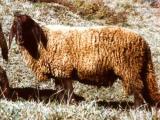
|
Red Engadine sheepRed Engadine sheep orginated in Switzerland in Lower Engadin and in the bordering Tirolian and Bavarian valleys. They originate from local varieties, from the Stone Sheep and the Bergamask sheep. They are medium to large framed and are distinguished by their ram nose and their long, hanging ears. |
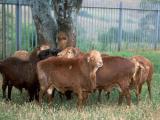
|
Red Masai sheepRed Masai are an East African fat-tailed type of hair sheep used for meat production. They are found in northern Tanzania, south central Kenya, and Uganda. |

|
Rhoen sheepOne of the oldest landraces in Germany was mentioned in 1844 in the files of the convent of Fulda: “The common sheep of the Rhoen farmer is a normal German sheep with peculiar characteristics, which even in foreign countries is known as Rhöenschaf. It is yellow-white with a black hornless head and is clothed in coarse, non-elastic wool, with little crimp. Its body is large, the bones are strong, and it lends itself to fattening.” |

|
Rideau sheepRideau sheep are one of three Canadian breeds. Their development began in 1968 at Agriculture Canada's Animal Research Centre in Ottawa when the Centre's Suffolk, Shropshire, and Dorset sheep were combined with imported breeds: Finnish Landrace and East Friesian. In 1974, the Rideau was closed to the introduction of new genetic material. |
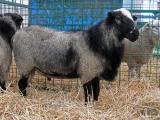
|
Romanov sheepThe Romanov sheep breed originated in the Volga Valley, northeast of Moscow. The name “Romanov” comes from the old royal family of Russia. These sheep were first noticed in the 18th century, and were later imported into Germany and then France. In 1980, the Canadian government brought in 14 Romanov ewes and 4 rams for testing and put them into quarantine for 5 years. After that, some were brought to the United States |

|
Romney sheepThe Romney is truly a versatile breed, as demonstrated by its ability to produce quality meat and wool under diverse climate conditions and management systems. It is so-named for the Romney Marsh region in Kent, England where it was developed as a dual purpose sheep. Due to the extreme geographic and climatic conditions of the region, Romney sheep developed some specific breed characteristics which include hooves which are resistant to footrot and fleeces which remain heavy in harsh weather. |

|
Rouge de l'Ouest sheepThe Rouge is a medium sized breed of excellent conformation without excessive bone. As its name suggests, its head, which is hornless, can vary from pink to deep red and is covered with fine hair. The breed is strong and deep through the chest with good length in back and loin, but it is the exceptional hind quarters and muscling that are immediately recognized as the powerhouse of the Rouge. |
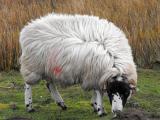
|
Rough Fell sheepThe Rough Fell is an exceptionally docile sheep that excels in hardiness and has no equal in its power to exist under adverse conditions. |

|
Roussin sheepRoussin Sheep were developed from, the Brittany Heath Sheep. Dishley Leicester and the Southdown. In the 1960's the breed was improved using Suffolk and Avranchin. In 1977, the breed was closed and the characteristics established. The main areas in France the Roussin are the Cherbourg peninsular, Normandy, and Brittany. The French sheep breeds tend to stay in their local areas. However Roussin Rams have been taken down to the Carmangue to be used on the feral sheep to produce fat lambs off the salt marsh. |
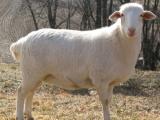
|
Royal White sheepThe Royal White® is a new breed of hair sheep privately funded and developed by William Hoag, of Dorpcroix Sheep Farm in Hermeleigh, Texas. The breed is a cross between the Dorper and St. Croix. |

|
Ryeland sheepRyelands are a white-faced, polled (no horns), small to medium sized, down-type breed whose antecedents were developed by monks at Leominster in the rye growing district of Herefordshire, England, in the 15th Century. It was one of the breeds used to introduce the poll gene to the Dorset breed in the development of the Poll Dorset. The Ryeland breed first came to New Zealand in 1903 and later to Australia. |
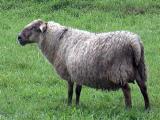
|
Saeftinger sheepThe Saeftinger breed originated around 1986 by crossing a Romanov ram onto Suffolk ewes. The breed takes its name from the salt meadows where it grazes. |

|
Santa Cruz sheepThere is considerable uncertainty as to the exact origin of the sheep of Santa Cruz Island, even to the century in which sheep were placed there. Speculation is that Merino, Rambouillet, and perhaps some Churro figure in the Santa Cruz sheep's background, and it is certain that the sheep have been feral for the last 70 years. The Nature Conservancy acquired 88% of the island (located off the coast of southern California) during the 1970's and began an eradication program in 1980. |
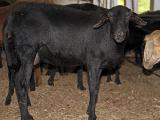
|
Santa Inês sheepThe Santa Inês is a breed of hair sheep found in Brazil. It is generally thought to be a cross of Morada Nova, the course-wooled Italian breed, Bergamasca, and the native coarse-wooled Crioula, followed by a period of selection or evolution for absence of fleece. Colors range from red, black and white and can be spotted or solid. They have large bodies, are long-legged and have large pendulous ears and are polled. |

|
Sardinian sheepThe Sardinian breed originated from the local lowland breed which were large, polled, and had white wool. Merino and Barbary breeding were also used in developing the breed. The males are occasionally horned and the females are polled (hornless). |

|
Scotch Mule sheepThe Scotch Mule is an intentionally produced crossbred sheep out of Scottish Blackface ewes and sired by Bluefaced Leicester rams. The term "mule" (when it refers to sheep) is used for an intentionally produced crossbred sheep that is sired by a Bluefaced Leicester ram. In the United Kingdom, Mule ewes are the backbone of the commercial sheep industry. The various types of Mules are the most popular commercial ewes in the UK, and the Bluefaced Leicester is the number one crossing sire there. |
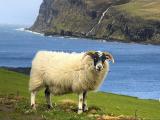
|
Scottish Blackface sheepThe Scottish Blackface is by far the most important blackface sheep in all of Great Britain. They are primarily used for crossing, usually with the Border or Bluefaced Leicester. They originated as a mountain sheep in Scotland, and there is a tradition that they came from a Spanish ship wrecked during the northward flight of Armada in 1588. The Scottish Blackface has a light weight fleece of long, coarse wool. Both sexes have horns. |
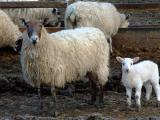
|
Scottish Greyface sheepBy using the Border Leicester ram with the Scottish Blackface ewe, the Scottish Greyface is produced. |

|
Shetland sheepThe Shetland's roots go back over a thousand years, probably to sheep brought to the Shetland Islands by Viking settlers. They belong to the Northern European short-tailed group of sheep, which also includes Finn sheep, Icelandic sheep, and Romanovs. The Shetland is a primitive, unimproved breed noted for its natural hardiness, lambing ease, longevity, and ability to survive under harsh conditions. It is one of the smallest breeds of sheep. |
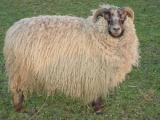
|
Shetland-Cheviot sheepFrom the turn of the 20th century, North Country Cheviot rams have been bred with the Shetland ewe to produce what has become locally as the Shetland-Cheviot. The hybrid vigor prdouced from the crossing the two pure breeds ensures that the Shetland-Cheviot retains the features of both. She is a hardy, thrifty, and milky with her sire's excellent conformation. |
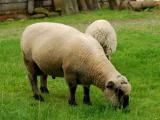
|
Shropshire sheepShropshires are a good, middle-of-the-road sheep, medium to large in size, with dark faces and wool on the legs. They originated in central western England in the counties of Shropshire and Stafford from native stock, Southdown, Leicester, and Cotswold crosses. First imported into the United States in 1855, until the 1930's, the Shropshire was the most popular and influential breed in the country. |
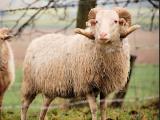
|
Skudde sheepThe Skudde is a nordic, short-tailed heather sheep. Its original homeland was East Prussia and the Baltic States. Today a few small herds can be found in these areas. The most noticeable feature of the Skudde ram is the imposing snail horn. The ewes are hornless or carry horn stumps. In individual cases, it occurs that ewes carry chamois-like “hornlets.” The animals are slender, the weight of the rams lies between 35 and 50 kg (77-110 lbs), that of the ewes from 25 to 40 kg (55-88 lbs). |

|
Soay sheepThe Soay has been called the only living example of the small, primitive sheep which inhabited the British Isles before the coming of the Norsemen and Romans. |

|
Solognote sheepThe Solognote is an old breed that derives its name from Sologne, France, where it was developed in the 15th century. |

|
Somali sheepThe Somali is a hair sheep native to Somali in Africa where they are reared primarily for meat production. |
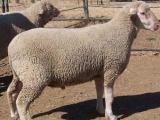
|
South African Meat Merino sheepSAMMs were imported into South Africa by the Department of Agriculture from 1936 to 1974 from Germany where the Deutsche Fliesch Merino is a common meat sheep of Germany, Austria, and Poland. In South Africa, the name was translated as Duits Vleis Merinoand then into English as German Mutton Merino. In 1974, the South African Breed Society changed the name to the South African Mutton Merino. |

|
South Suffolk sheepThe South Suffolk is a fixed cross between the Suffolk and Southdown breeds. It is a large, comparatively heavy meat breed of sheep. |

|
South Wales Mountain sheepSouth Welsh Mountain sheep have been reared on the harsh hill pastures of South Wales for centuries. Their ability to thrive where lesser breeds have failed has ensured their predominance in the area. They are a dual purpose breed. They are similar in appearance to other Welsh Mountain breeds, and rams are frequently used to improve the size and conformation of the other Welsh Mountain breeds. |

|
Southdown sheepThe Southdown takes its name from the Chalk Hills of Sussex County in extreme southeastern England where they are said to have roamed from time immemorial. They are one of the oldest sheep breeds, having contributed to the foundation stock of all other down breeds: Suffolk, Hampshire, and Oxford. |

|
Spael sheepThe Norwegian Spael sheep is named after the short, nearly wool-less tail (spælen). It originates from the old Norwegian landrace of sheep. In 1912, two breeding stations were established to prevent extinction of the breed. Icelandic sheep were crossed onto the Spael sheep through semen import in the 1960's and 1970's. Finnsheep and Faeroe Island sheep were also used in the breeding of Spael sheep. |
| 1 | 2 | 3 | 4 | 5 | 6 | 7 | 8 |